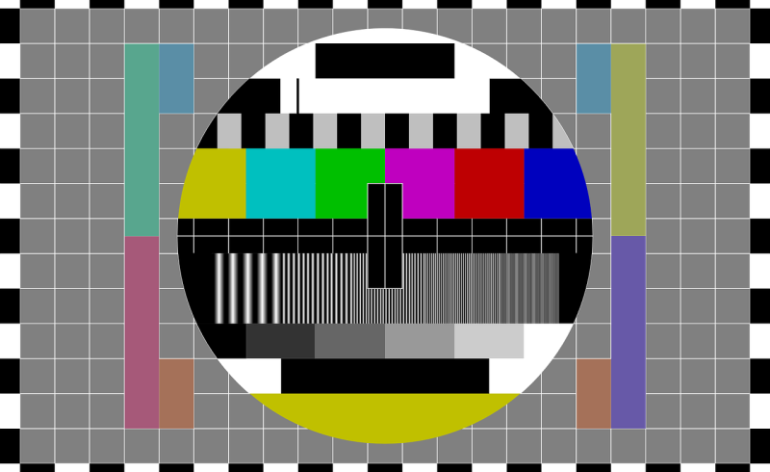Guide to Screen Burn-in and Image Retention
Screen burn-in and image retention are two concerns that many people have when buying a new TV. We hear lots of stories from people about which TVs we should or should not buy by armchair AV experts based on information they got from their uncle. One of the most common warnings is about which TVs can “burn-in” and which do not. There is a lot of misinformation out there and we are here to clear it up.
What is Screen Burn-in and Image Retention
These are technically two different things. Screen burn-in is when an image is displayed so long on a screen that is can be seen on the screen even when the screen is off (in extreme cases) or can be seen occasionally through other images. This occurs when certain sub-pixels have been so bright for so long that they literally cannot return to their default state anymore. They are permanently “stuck” in a non-neutral state, so they will always produce a “ghost” image forever.
Image retention is when your display switches from displaying one image, to a different one quickly. If you can see the “shadow” of the first image in the second for a short while, this is image retention. Are you a news junkie or a hardcore gamer? You may have already experienced image retention. If you can see the logo of the news channel or the life bar of your character when you change channels for a little while, that was image retention.
Retention can be experienced by all screens. If you are displaying a very bright, static image for a long time and then switch to a dark image, you may see the shadow of the first image. In realistic tests, image retention is not a problem for any type of TV. In general use, image retention should be almost imperceptible to your eye.
But if you are someone that turns a TV on in the morning and leaves it on all day, you should be worried about burn-in. We know too many people that use their news channels as white noise. They never switch the channel and they almost never turn their TVs off. If that is actually the case, burn-in really shouldn’t be a problem. Everything that you are burning-in is what you are watching anyhow. In these extreme cases, the burn-in only becomes visible during the commercials.
Is My TV Susceptible to Burn-in or Image Retention?

Do you have a projector? You don’t have to worry about burn-in. Do you have an LCD television? Burn-in is practically impossible. The TV will break before you experience burn-in. So, what TVs do you need to worry about? Plasma’s and OLED’s.
Plasma TVs and Burn-In
One of the big knocks about Plasma displays back in the day was the claim that they were very susceptible to burn-in. With early models, this was true. The later models were much more robust. We know of many users of plasma’s that still have never experienced burn-in. As plasma TVs are no longer sold, this is a non-issue for new buyers. For people still rocking a plasma, if you haven’t experienced burn-in by now, keep doing what you are doing. You are unlikely to see burn-in on your display.
OLED TVs and Burn-In
Early OLED models were susceptible to burn-in. Newer models are much more robust. Does this sound familiar? Much of the screen burn-in rhetoric comes from the LCD camp. They are looking for reasons for you to buy an LCD when OLEDs look better and are becoming more and more competitive in prices. But, it is true that OLEDs can burn-in. If you abuse your OLED, you can experience screen burn-in and longer-term image retention. So, how can you stop it?
What Causes Image Retention and Screen Burn-in?
The basic cause of burn-in and image retention is NOT watching the same channel too much. The real reason is improper settings. If your backlight and contrast are set too high, your TV will be much more in danger of burning-in. Manufacturers are building in protections for their displays. For example, LG has a “Logo Detection” setting. If it senses that part of the image – like a channel logo – hasn’t changed at all for a few minutes, it will dim that portion of the screen, and eventually the entire screen to reduce the chances of burn-in. Let’s discuss what you can do to protect your display.
Fighting Image Retention and Screen Burn-in
There are a lot of steps you can take to ensure that your display will not experience burn-in. The first, and easiest, is to NOT abuse your display. Don’t have it on the same channel for 13 hours a day, every day. That alone will ensure you never experience burn-in. But there are a few additional steps you can take:
Proper Display Settings
The first thing you’ll want to do after plugging in your display is to change the settings. This isn’t just for OLEDs, this is for EVERY display. While you can find specific settings for your specific display online, in general, you’ll want to switch it off the default video mode. Often called “vivid” or something similar, this mode is to make the display look good on the showroom floor. You’ll want to look for something that looks like “cinema” or “theater” or “dark” mode. These will lower the backlight and contrast to more reasonable levels. With most displays, this is all you’ll have to do. You should do a quick search for your specific display to see if there are other recommendations. In particular, you’ll want to search for “backlight setting” for your display (LG calls this OLED Light). Many manufacturers set this too high even in the cinema picture mode. On LG OLEDs for example, we recommend no higher than 40. Again, models differ from year to year so double-check.
Pixel Shift Options
OLEDs now have “Pixel Shift” options. Some have more than one. You’ll have to consult your manual to see exactly how they are implemented on your display but the general idea is to slightly move the image around the screen to avoid burn-in. With smaller images, this can help. Larger logos or health bars in games are less likely to be affected. There is no evidence that using these options harms your TV in any way. You should enable them and have them run as often as is convenient. The ones that run longer and flash different colors on your screen are looking to even out the aging of the subpixels. These functions should be disabled as they will prematurely age your screen if overused. After using an OLED for four hours or more and powering it off, do not unplug it. Do not turn it back on for at least 15 minutes. Newer OLEDs run a short “pixel refresh” cycle while in standby after every four hours of use.
Watching Different Content

Obviously, watching the same content non-stop is the main cause for screen burn-in and image retention. If you have your display in the proper video mode, it will go a long way to protecting your screen. But nothing protects it as much as not having it display a new channel’s logo in the lower left-hand corner for hours a day. Change the channel, turn off the TV, basically, give the pixels a break. By displaying that logo, the colors displayed are being used more than the others. At the very least, you risk those colors fading in that area faster than the rest of the screen. You may not have burn-in, but that area will never look right again.
Stuck Pixel Fix
If you visit YouTube, you’ll find a lot of videos for “stuck pixels.” This is a similar but different issue from burn-in. Some people will suggest these videos as a fix for burn-in. Generally, they flash different screen colors, or blocks of color, over a long time period. Like the longer Pixel Shift options above that flash different screen colors, these will only prematurely age your screen. We would not suggest using these as a fix for burn-in.
Conclusion
The reality is that, with proper settings and reasonable usage, burn-in and screen image retention should NEVER be an issue. Follow our guide to make sure you’ve taken the basic steps to protect your display and you’ll be fine.
If you want to read more about burn-in, check out this article at Rtings.com conducting a long-term test on three different types of displays.


